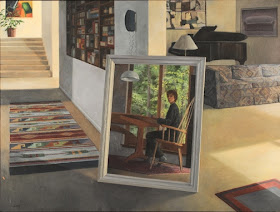 |
| "Backview" from Patrice Wolf's Landscape Series |
As it turns out, his wife is likewise an artist whose work is similarly impressive. I asked permission to share her work here, as well as some of her story.
 EN: How did you come to recognize that you had a gift (or knack) for the arts?
EN: How did you come to recognize that you had a gift (or knack) for the arts?
Patrice Wolf: I guess I would credit the support and reinforcement from my parents. I loved drawing from life and faces in particular. I made a drawing of Giacometti before I had any art training and didn’t really know who he was. I just wanted to draw his face. A few years ago a friend told me to read “A Giacometti Portrait” by James Lord. It’s one of my favorite books. I do have a particularly strong memory of when I was around 7 or 8 years old. I was walking home from school one warm spring afternoon. Part of the walk home took me through a prairie where there were blackberry bushes that the neighborhood kids would pick. I remember stopping for some berries on the path and looking at a drawing I made at school of a Scottie dog and admiring it. Having a number of sensual pleasures all at one time reinforced the memory for me and I’m pretty sure I got a good grade on the drawing too.
EN: What was it that attracted you to pursue graphic design as a major?
PW: I needed to get a decent paying job. I was a single mom, recently divorced, and I thought it would be a creative way to make a living.
EN: What led you to pursue a Masters in Fine Arts instead?
 |
| Ron Kroutel with wife Pat. |
EN: Who were your favorite artists at that time? Who have been the artists you most admire today?
PW: I saw an exhibition of Giorgio Morandi at the Guggenheim that had a strong and lasting effect on me. I loved the immediacy and intimacy of Avigdor Arika. I had always been drawn to Van Gogh’s work at the Art Institute of Chicago on my visits there growing up and then going to the Van Gogh Museum in Amsterdam in the late ‘80s really fired me up. Today I look to the quiet power of Spanish artist Isabel Quintanilla; Tom Thomson, one of the early 20th century Canadian Seven landscape painters; Lucien Freud; William Nicholson, the father of the British artist Ben Nicholson; and Manet’s poignant, late flower paintings to name a few.
 |
| "Flight" -- Collaboration, Patrice Wolf/Ron Kroutel |
 |
| "Echo" |
PW: Ron and I were curious to try a collaboration. Since both of us work directly from life we thought we’d change it up and try working from photographs to see how two visions and two personalities responded to the same photo. We decided on a consistent size and format (24”x24”) paintings on canvas. We would alternate taking a photo of a local landscape, then we would each take the photo to our respective studios and make a painting of it, using it as a jumping off point to explore ideas. This would be done in secret so that we didn’t know what the other was doing. When we were finished and put the two together as a diptych, it was always a surprise. Shown side by side we see the paintings from different perspectives and sometimes an unintended narrative between the two is suggested.
EN: The cups are very cool. How large are these pieces and on what kind of surface? What was the impetus to do a series of cups?
PW: Most of them are 8”x10”, oil on canvas. They are all painted from life within arm’s reach. I think of them as meditational portraits. Most of the cups were inherited from long gone relatives and were chosen intuitively. There is something tender and fragile, intimate and ephemeral about them that I wanted to capture. Years ago while in a glass museum in Venice I spotted a small, simple, glass that was 2000 years old. It looked so vulnerable and ordinary but it had a profound effect on me.
EN: Your landscapes are especially impressive. What is your process for tackling such a complex scene and translating it to canvas? Is there an emotional attachment to this place that you sought to capture.
 |
| "Dow Lake Reeds and Grass in Water" |
 |
| "Dow Lake Summer" |
EN: Your charcoal self-portraits are very nice. Do you like working in charcoal?
PW: I feel very comfortable working in charcoal. It’s like oil painting in that it’s a very forgiving medium. I can make lots of changes/adjustments and the image just seems to gain in richness and depth.
EN: How has being an artist changed you as a person?
PW: Painting and drawing have given me a focus, a way to understand and analyze the world. It’s made me more humble and appreciative. I feel very fortunate that I have the ability to paint and that I can do so even as I grow old.
* * * *
Thank you, Patrice.
Related Links
Ron Kroutel
Frank Holmes
Jill Mackie
Meantime, art goes on all around you. Be enriched.


No comments:
Post a Comment